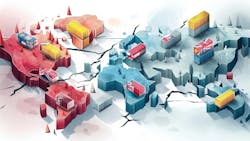How manufacturers can unlock new supply chains through localization
What you’ll learn:
- Moving production closer to home is not just about where things are made. It now includes how products are designed, sourced, and managed.
- Recent geopolitical events, such as Russia’s invasion of Ukraine, and the global aftershocks from U.S. tariffs, have exposed the weakness of relying on single-source supply chains.
- Industrial AI is emerging as a key tool to help manufacturers take the localization leap.
In the wake of global disruptions such as geopolitical tensions, U.S. trade tariffs, and labor shortages, localization has become a key strategy to help manufacturers reimagine supply chains and better prepare for emerging unknowns.
But moving production closer to home is not just about where things are made. It now includes how products are designed, sourced, and managed. Manufacturers can strengthen localized supply chains in four key business areas: product design and standardization, remanufacturing, ESG reporting, and scenario planning powered by industrial AI.
See also: How digital transformation and AI can redefine supply chains
Recent geopolitical events, such as Russia’s invasion of Ukraine, and the global aftershocks from U.S. tariffs, have exposed the weakness of relying on single-source supply chains.
Manufacturing decisions are no longer made based on sourcing the cheapest product, but sourcing what is available. In response, there’s been a strong push for manufacturers to shift from “just-in-time” to “just-in-case” models and to diversify their supplier networks.
Localization has been redefined and has become the order of the day. In fact, 68% of top management executives see supply chain localization as a top priority this year. But localization isn’t a quick fix.
It comes with its challenges—outdated logistics networks causing delays and increases in distribution costs along with pivoting to locally sourced raw materials, made worse by gaps in connectivity and advanced technology that further hinder visibility, tracking, and coordination across new supply chains.
Industrial AI is emerging as a key tool to help manufacturers overcome these hurdles and take the localization leap. The payoff is certainly worth it. Even a small investment in localization can yield significant supply chain performance improvements.
See also: The $2 trillion AI revolution: How smart factories are rewriting the rules
A recent study found that 82% of companies were able to improve resiliency with localization, and a further 77% benefited from cost reductions thanks to lower transportation expenses, reduced tariffs from international trade, and mitigating currency fluctuation risks.
To capitalize on these gains, manufacturers must embed localization into the core of their operations, starting with four key business areas:
Product design: Start by making components easy to source
One of the most overlooked causes of supply chain vulnerability is product design. Highly customized components can limit a manufacturer’s flexibility by tying them to single-source suppliers or long-lead-time-parts that are difficult to replace during supply chain disruptions.
This is why manufacturers that simplify product designs by shifting from bespoke to standardized components can open themselves up to a wider pool of suppliers, including those closer to home.
Agile automotive manufacturers led by example during the semi-conductor shortage by making decisions to replace custom chips with more commonly used multipurpose ones that are found in consumer electronics. In doing so, they were able to offset the initial dip in revenue, which saw global car sales in 2021 down by more than 12% compared to 2019.
See also: How agentic AI can be a 'force multiplier' in IT and OT cybersecurity
Standardization helped the industry become less dependent on certain critical resources and allowed companies to build more resilient and shorter supply chains. So, what key lessons can be learned from this experience?
Manufacturers that design with flexibility in mind and pivot to standardized, modular designs can support faster procurement, reduce lead times, and make it easier to manage inventory, all while enabling quicker responses to shifts in customer demand and raw material availability.
Remanufacture to close the loop and turn waste into value
As remanufacturing reduces the need for raw material extraction and long-distance transport, it can be a crucial strategy for manufacturers to reduce carbon footprints and supply risk.
In fact, the Environmental Protection Agency calls out remanufacturing as one of the most effective ways to lower environmental impact while conserving resources. Local dismantling and repair centers also bring production physically closer to the consumer, which creates regional loops that are more sustainable and responsive.
See also: AI sparks demand for specialized, high-performance plant infrastructure
Research estimates that the automotive remanufacturing market in the U.S. is projected to grow significantly, reaching an estimated value of $24.30 billion by 2030, as manufacturers compete to keep costs low. But this barely scratches the surface of how remanufacturing can benefit manufacturing companies.
When manufacturers add industrial AI into the mix, the potential to streamline remanufacturing processes becomes tenfold. Industrial AI can assess which components are reusable, match recovered parts to new production needs, predict failures to improve recovery planning, identify the shortest supply chain, and even flag companies that can use one company’s waste as their raw material.
When it comes to core forecasting, industrial AI tools can even help remanufacturers reduce core safety stock by 2% to 4% and save 3% to 5% in freight costs by reducing the cost of expedited shipping.
Ethics and emissions are the new bottom line
Sustainability practices are no longer just good for the planet; they’ve become essential for long-term business success. Regulators, investors, and consumers now expect greater transparency from companies, especially around Scope 3 emissions.
Witness the fact that 80% of American consumers would be willing to pay more for sustainable products, driven by their commitment to environmental health.
See also: Digitization for circular advantage: Enabling sustainable manufacturers to thrive
Supply chain localization offers a way to reduce transportation emissions and allows for better oversight of supplier practices, including energy use and labor conditions, which can help ensure manufacturers meet regulatory targets. But how can manufacturers clearly display that their companies are meeting these?
Sustainability at the back end needs to be visible, transparent and auditable, which is where AI-driven data collection and analysis is key in producing these records. Manufacturers can use Industrial AI to automate emissions calculations and embed sustainability into daily operations. This can help businesses achieve accurate carbon insights at scale and embed sustainability into day-to-day operations.
Let AI connect the dots with real-time scenario planning
The final piece of the puzzle is scenario planning. Currently, just 5% of organizations globally can proactively predict and mitigate disruption before it impacts their business.
What’s more, 75% of global manufacturers are still utilizing static systems and siloed organizations with minimal collaboration between engineering and supply chain teams.
See also: Agentic leaps past Gen-AI in its ability to solve production plant problems
This is where real-time intelligence and always-on insights can enable a more proactive approach to supply chain risks—and industrial AI holds the key.
Shift from reactive to proactive decision-making
Manufacturers can use agentic AI systems embedded into their enterprise systems to say goodbye to what-ifs and instead simulate disruptions and re-plan in minutes.
Where previously scenario planning would have taken a week for a human-led team to test a few key factors, AI agents can ingest massive datasets—be that supplier performance, geopolitical risk, weather—and suggest real-time actions based on learned patterns.
See also: How can manufacturing survive and thrive in the tariff era?
AI also enables upside-down material requirements planning logic by suggesting what can be built with available inventory, rather than just what should be built based on outdated assumptions.
For example, if a supplier experiences delays during a specific holiday season, AI can flag the risks and suggest alternative products that manufacturers can make based on the resources available to ensure the production program is not disrupted.
Industrial AI holds all the aces in localizing the supply chain
The traditional cost-optimize-supply chain model is no longer fit for purpose. Manufacturers must now operate in a world where disruption is the “new” norm, and where sustainability, ethics, and responsiveness are just as important.
Manufacturers that take the time to rethink how products are designed, embrace circular models, act on emissions data, and leverage Industrial AI for planning, will be able to turn supply chain localization into a new value-add.
This isn’t just about surviving the next shock, it’s about thriving in a new supply chain era where Industrial AI holds all the cards, and resilience and responsibility go hand in hand.
About the Author

Maggie Slowik
Maggie Slowik is a global industry director for manufacturing at IFS, supporting customer strategic business needs. Prior to IFS, she was a manufacturing analyst at IDC, working with both global software providers and manufacturers to help assess, define and drive digital transformation initiatives. Previous roles include advisory work with supply chain C-suite members on topics including sustainability, supply chain risk and technology selection.

Andrew Burton
Andrew Burton is an IFS industry director for manufacturing and has more than 40 years of supply chain experience, mostly in aerospace and defense, discrete manufacturing and niche automotive. In past roles, he has been an IFS “super user” and an independent IFS consultant.
